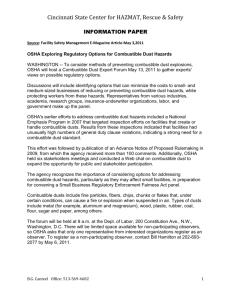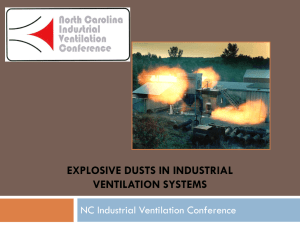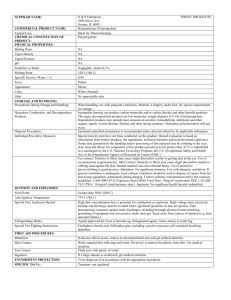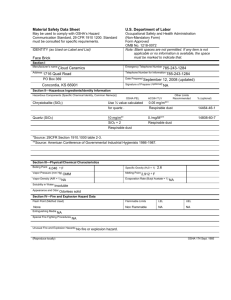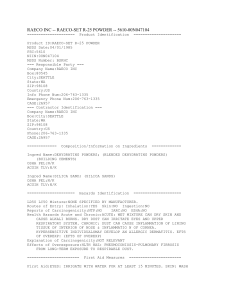Lesson Plan - Georgia Tech OSHA Consultation Program
advertisement
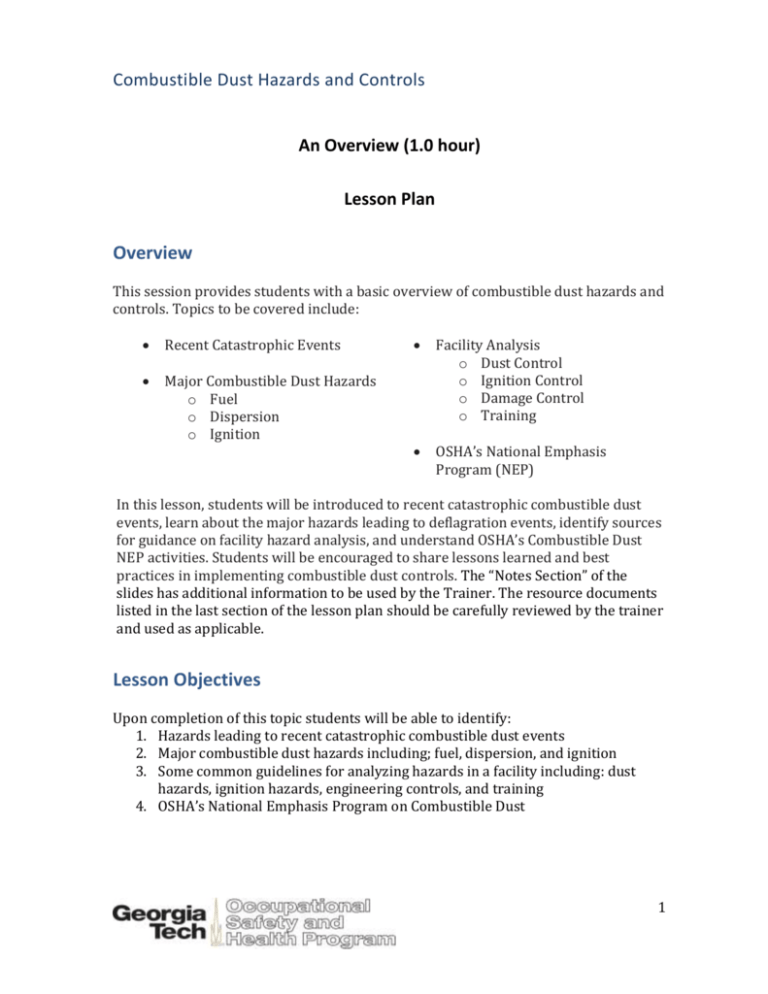
Combustible Dust Hazards and Controls An Overview (1.0 hour) Lesson Plan Overview This session provides students with a basic overview of combustible dust hazards and controls. Topics to be covered include: Recent Catastrophic Events Major Combustible Dust Hazards o Fuel o Dispersion o Ignition Facility Analysis o Dust Control o Ignition Control o Damage Control o Training OSHA’s National Emphasis Program (NEP) In this lesson, students will be introduced to recent catastrophic combustible dust events, learn about the major hazards leading to deflagration events, identify sources for guidance on facility hazard analysis, and understand OSHA’s Combustible Dust NEP activities. Students will be encouraged to share lessons learned and best practices in implementing combustible dust controls. The “Notes Section” of the slides has additional information to be used by the Trainer. The resource documents listed in the last section of the lesson plan should be carefully reviewed by the trainer and used as applicable. Lesson Objectives Upon completion of this topic students will be able to identify: 1. Hazards leading to recent catastrophic combustible dust events 2. Major combustible dust hazards including; fuel, dispersion, and ignition 3. Some common guidelines for analyzing hazards in a facility including: dust hazards, ignition hazards, engineering controls, and training 4. OSHA’s National Emphasis Program on Combustible Dust 1 Training Resources PowerPoint Presentation: Combustible Dust Hazards and Controls: An Overview with instructor’s notes LCD Projector, screen (if needed), computer, speakers (if needed Internet access (if available) Variety of condiment packets containing varying sized particles (ex. “raw” sugar, white sugar, salt, artificial sweetener, etc.) Activities and Classroom Procedures 1. PowerPoint slides 2. Class discussion of key concepts 3. Facilitation of interchange of ideas among participants Lesson Roadmap 1. Introduction a. Slides to be used: 1-2 b. Objectives Covered: None c. Exercise/Demos: None d. Training Aids: PowerPoint slides 2. Catastrophic Combustible Dust Events a. Slides to be used: 3-10 b. Objectives Covered: 1 c. Exercise/Demos: Utilize Chemical Safety Board (CSB) website, show 9 minute CSB video on the Imperial Sugar Explosion (link: http://www.csb.gov/videos/inferno-dust-explosion-at-imperialsugar/) video can be downloaded in advance if internet is not available during presentation. d. Training Aids: Use of PowerPoint slides, CSB website, CSB video on Imperial Sugar Explosion 3. Dust Explosion Requirements a. Slides to be used: 11-15 b. Objectives Covered: 2 c. Exercise/Demos: Discuss the required elements for creating a combustible dust explosion hazard d. Training Aids: PowerPoint slides 4. Dust Explosion Requirements: Fuel 2 a. Slides to be used: 16-33 b. Objectives Covered: 2 c. Exercise/Demos: In conjunction with slide 23, demonstrate using overhead projector (or hand out to students) a variety of readily available products in a variety of particle sizes (ex. Sugar packet, sweetener, salt, “raw sugar” and demonstrate which particle sizes constitute a deflagration risk d. Training Aids: PowerPoint slides; overhead projector (if available), a variety of condiment packets with varying sized particles (sugars, salt, sweeteners, etc.) 5. Dust Explosion Requirements: Dispersion a. Slides to be used: 34-43 b. Objectives Covered: 2 c. Exercise/Demos: Discuss that while a relatively dense dust cloud is required to propagate a deflagration, those dust levels rarely exist on a production floor. Instead, an explosion will begin in process equipment, creating a pressure wave that liberates accumulated dust, creating explosive concentrations. Show a video that demonstrate creation of a dust cloud, such as “Mythbusters Creamer Cannon,” which can be found at (http://www.youtube.com/watch?v=yRw4ZRqmxOc). d. Training Aids: PowerPoint slides, internet access to video 6. Dust Explosion Requirements: Ignition a. Slides to be used: 44-48 b. Objectives Covered: 2 c. Exercise/Demos: Demonstrate classified vs. non-classified electrical equipment. d. Training Aids: PowerPoint slides 7. Facility Analysis a. Slides to be used: 49-64 b. Objectives Covered: 3 c. Exercise/Demos: Discuss how dust control, ignition control, engineering controls, and training all play a role in mitigating combustible dust hazards d. Training Aids: PowerPoint slides 8. OSHA National Emphasis Program a. Slides to be used: 65 – 71 b. Objectives Covered: 4 c. Exercise/Demos: Optional: Visit NPFA website to view standards; visit OSHA website to view Combustible Dust page and resources. d. Training Aids: PowerPoint slides, internet access. 3 Evaluation and Assessment a. Interactive discussion, exchange, demonstration of concepts Resources/Web Sites OSHA Web Page – www.osha.gov Specific OSHA Web Pages: o https://www.osha.gov/dsg/combustibledust/index.html o https://www.osha.gov/dte/grant_materials/material_listing_topic.html#c Chemical Safety Board o http://www.csb.gov/videos/combustible-dust-an-insidious-hazard/ o http://www.csb.gov/imperial-sugar-company-dust-explosion-and-fire/ National Fire Protection Association o http://www.nfpa.org/ GESTIS Dust Database o http://staubex.ifa.dguv.de/?lang=e Georgia Tech Research Institute, Combustible Dust Resources o http://www.oshainfo.gatech.edu/comb-dust-resources.html 4
